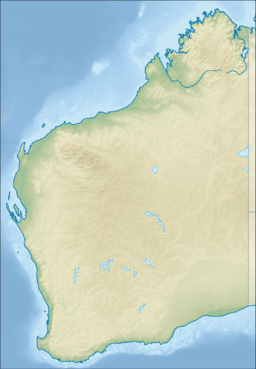Lake Way facts for kids
Quick facts for kids Lake Way |
|
|---|---|
| Location | Mid West, Western Australia |
| Coordinates | 26°47′03″S 120°20′09″E / 26.78417°S 120.33583°E |
| Type | Dry saline |
| Primary inflows | Surface runoff |
| Basin countries | Australia |
| Surface area | 460 km2 (180 sq mi) |
Lake Way is a large, flat area in Western Australia that is usually dry. It's known as a "dry lake" or "salt lake" because it only fills with water after very heavy rains. The lake is found in the Mid West region, about 15 kilometres (9.3 mi) south of a town called Wiluna. A nearby cattle station, which is a large farm for cows, is also named after the lake.
About Lake Way
Lake Way is mostly dry, but it has filled up with water during big floods. This happened in years like 1900, 1942, 1963, and several times between 1992 and 2006. The lake stretches out next to the road that connects Leinster and Wiluna, which is part of the Goldfields Highway.
This area is also important for mining. Lake Way is home to a major project that aims to mine uranium. A company called Toro Energy is working on this project, which is called the Centipede–Lake Way project. Toro Energy also owns another uranium project nearby, called the Lake Maitland project.
Mining History
Mining has taken place at Lake Way for different valuable materials.
Gold Mining
For a time, there was an open-pit gold mine at Lake Way. An open pit is a type of mine where minerals are dug up from a large hole in the ground, rather than from tunnels underground. This gold mining operation was part of the larger Wiluna Gold Mine.
The Williamson pit was a specific mining area located right inside the lake. Miners could reach it using a special raised road called a causeway. Gold was dug from this pit between 2005 and 2007. However, the amount of gold found was less than expected. Sadly, a mining incident occurred at the open pit in July 2005.
The company that owned the mine at the time, Agincourt Resources, later created a new company called Nova Energy in 2005 to focus on uranium. Eventually, Nova Energy became part of Toro Energy in 2007.
Uranium Mining Plans
For several years, there was a rule in Western Australia that stopped uranium mining. This rule was lifted in 2008 after a state election, when a different political party, the Liberal Party of Australia, came into power. After this, two uranium mining projects in Western Australia were expected to start producing uranium by 2012-2013. These included the Lake Maitland project and the Centipede–Lake Way project, which is run by Toro Energy.
Some groups, like the Anti-Nuclear Alliance of Western Australia, have spoken out against uranium mining projects in the state. They have tried to stop these projects from starting active mining.
The idea of mining uranium at Lake Way is not new. It was first suggested in 1978 by two companies, Wyoming Mineral Corporation and Delhi International Oil. In 1982, the Australian Government gave permission for the mine to be developed, but the project was stopped the next year. If it had gone ahead, mining would have involved digging many small open pits spread over a large area.
Today, Toro Energy plans to mine uranium at two main spots at Lake Way. One is called the Lake Way deposit, at the northern end of the lake. The other is the Centipede deposit, on the southwestern side. Toro plans to use a method called "heap leach" to get the uranium out of the rock. This method involves piling up the ore and using chemicals to separate the uranium. They expect to produce about 700 tonnes (690 long tons; 770 short tons) of uranium each year for 10 years.
In February 2010, Toro Energy received good news from the Western Australian Minister for Environment, Donna Faragher. The government agreed with the environmental plans for the Wiluna project. Before this, the government had also approved a test pit at Lake Way. This trial was also approved by the traditional owners of the land. After getting these approvals, Toro carried out an eight-week test pit operation in May 2010.
In 2010, a Western Australian politician named Robin Chapple asked why some uranium-bearing rock was still left uncovered and unfenced at Lake Way. This question had also been asked back in 2000. The Department of Mines and Petroleum confirmed that the material was naturally occurring rock that contained uranium.



